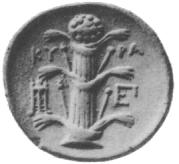Zaria Gorvett recounts the story of a Roman-era herb that was at one point literally worth its weight in gold:
Long ago, in the ancient city of Cyrene, there was a herb called silphium. It didn’t look like much – with stout roots, stumpy leaves and bunches of small yellow flowers – but it oozed with an odiferous sap that was so delicious and useful, the plant was eventually worth its weight in gold.
To list its uses would be an endless task. Its crunchable stalks were roasted, sauteed or boiled and eaten as a vegetable. Its roots were eaten fresh, dipped in vinegar. It was an excellent preservative for lentils and when it was fed to sheep, their flesh became delectably tender.
Perfume was coaxed from its delicate blooms, while its sap was dried and grated liberally over dishes from brains to braised flamingo. Known as “laser”, the condiment was as fundamental to Roman haute cuisine as eating your food horizontally in a toga.
[…]
Indeed, the Romans loved it so much, they referenced their darling herb in poems and songs, and wrote it into great works of literature. For centuries, local kings held a monopoly on the plant, which made the city of Cyrene, at modern Shahhat, Libya, the richest in Africa. Before they gave it away to the Romans, the Greek inhabitants even put it on their money. Julius Caesar went so far as to store a cache (1,500lbs or 680kg) in the official treasury.A coin of Cyrene depicting the stalk of a Silphium plant. (Source: 1889 edition of Principal Coins of the Ancients, plate 35, via Wikimedia)
But today, silphium has vanished – possibly just from the region, possibly from our planet altogether. Pliny wrote that within his lifetime, only a single stalk was discovered. It was plucked and sent to the emperor Nero as a curiosity sometime around 54-68AD.
With just a handful of stylised images and the accounts of ancient naturalists to go on, the true identity of the Romans’ favourite herb is a mystery. Some think it was driven to extinction, others that it’s still hiding in plain sight as a Mediterranean weed. How did this happen? And could we bring it back?




